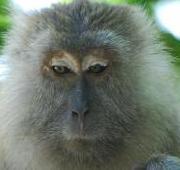 The crab-eating macaque is a medium species of monkey, found in the tropical and sub-tropical forests and jungles throughout South-East Asia. The crab-eating macaque differs from other macaque species in the fact that the crab-eating macaque has a long tail which is about the same length as it's body.
The crab-eating macaque is a medium species of monkey, found in the tropical and sub-tropical forests and jungles throughout South-East Asia. The crab-eating macaque differs from other macaque species in the fact that the crab-eating macaque has a long tail which is about the same length as it's body. The crab-eating macaque is widely dispersed across the South-East Asian jungles and are found in a variety of different habitats. The crab-eating macaque generally settles in areas that are close to water over a wide range of habitats including lowland forests, tropical jungles and mangroves.
The crab-eating macaque is widely dispersed across the South-East Asian jungles and are found in a variety of different habitats. The crab-eating macaque generally settles in areas that are close to water over a wide range of habitats including lowland forests, tropical jungles and mangroves.


Despite its name, the crab-eating macaque does not only eat crabs and in fact at least 50% of the crab-eating macaque's diet is made up from fruits, nuts and seeds. The crab-eating macaque also eats insects, small reptiles, amphibians, fish and crustaceans.
The crab-eating macaque is relatively small in size and therefore has a number of predators within its natural environment. Tigers and large reptiles such as snakes and crocodiles are the main predators of the crab-eating macaque along with large birds of prey like eagles who prey on the smaller crab-eating macaque individuals.
After a gestation period of around six months, the female crab-eating macaque gives birth to a single infant (baby) crab-eating macaque. Male crab-eating macaque babies remain with their mothers until they are a couple of years old and are independent enough to find another troop, but the crab-eating macaque babies tend to remain in the troop for their whole lives.
Although the crab-eating macaque is not considered to be a animal under threat at this time, habitat loss in the form of pollution but primarily deforestation is causing sever declines in the crab-eating macaque population numbers.

